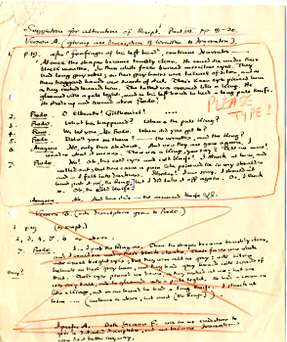Critics and the public
The critic Paul Ferris wrote in 1955 in The Observer that the first series offered "the best light listening for the next five weeks ... [with the] pure quality of fairy-tale ... charming without being slight". [13] Lee records that another early review in an unknown newspaper, preserved in the BBC archives, stated that the "relaxed, vivid, and masculine style" of Tolkien's writing somehow adapted quite naturally to the medium of radio. The reviewer was comfortable, too, with the passages voiced by the narrator, saying that even in explanations Tolkien was able to hold the listener's attention. Listeners' reactions were analysed by the BBC's audience researchers in the 1950s. They found that 1 adult in 1000 in Britain had listened in. For the first series, audience appreciation had by the last episode reached 64 out of 100 from an initial score of 56, against an average for all programmes on the channel of 65.
Lee added that most of the recorded comments were very positive. He notes that listeners were divided about whether the series was "a milestone in BBC history", or a waste of listeners' time on a serious channel playing material meant for children. Overall, listeners enjoyed the first series, where Tiller had followed Tolkien's advice to make a selection of scenes and cut the rest. They were far more critical of the second series, where Tiller had compressed many scenes, resulting in what a self-described "Civil Servant" called "a footling and ridiculous sounding adventure story of the 'with one bound Jack was free' type".
Tolkien's opinion
Tolkien had had, in Lee's words, "a long and strained relationship with the BBC", starting in 1936 with a broadcast of his modern English version of the medieval poem Pearl . Tolkien from the start sceptical about reducing nearly 400 pages of The Lord of the Rings to less than five hours of radio. He stated directly that he would prefer scenes to be cut rather than compressed to mere summaries.
Tolkien's opinion on these broadcasts was revealed in several of his letters. In November 1955, he told Molly Waldron that he believed that the book was "quite unsuitable for 'dramatization', and have not enjoyed the broadcasts—though they have improved. I thought Tom Bombadil dreadful—but worse still was the announcer's preliminary remarks that Goldberry was his daughter (!), and that Willowman was an ally of Mordor (!!)." [14]
The following month, Tolkien wrote to the novelist Naomi Mitchison "I think poorly of the broadcast adaptations. Except for a few details I think they are not well done, even granted the script and the legitimacy of the enterprise (which I do not grant). But they took some trouble with the names. I thought that the dwarf (Glóin not Gimli [...]) was not too bad, if a bit exaggerated." [15] The same day, he wrote to Rayner Unwin that he "agreed with the [newspaper] 'critics' view of the radio adaptation" but was "annoyed" that they should "turn their attention" on him and the book when they admitted they had not read it. [16] Further, he found the speakers on the BBC's programme The Critics "intolerable with a superiority that only ignorance can maintain". However, he noted that the review in The Times "was appreciative". As for the radio series itself, Tiller had in his view "managed excellently" with the Elves and the Council of Elrond, but had wrongly made Bilbo Baggins sound bored.
In November 1956, Tolkien wrote to Tiller concerning the accents to be used in the production of a second series: "I paid great attention to such linguistic differentiation as was possible: in diction, idiom and so on; and I doubt if much more can be imported, except in so far as the individual actor represents his feeling for the character in tone and style." [9] A few days later, he wrote to Tiller again concerning scripts for three of the episodes, saying, "Here is a book very unsuitable for dramatic or semi-dramatic representation. If that is attempted, it needs more space, a lot of space. ... Personally, I think it requires rather the older art of the reading 'mime', than the more nearly dramatic, which results in too great an emphasis on dialogue (mostly with its setting removed). ... I feel you have had a very hard task." [10]
Tolkien was unimpressed by the results. Replying to Rayner Unwin in 1957 concerning an enquiry about the possibility of making a cartoon of The Lord of the Rings, he wrote: "I think I should find vulgarization less painful than the sillification achieved by the B.B.C." [17]


